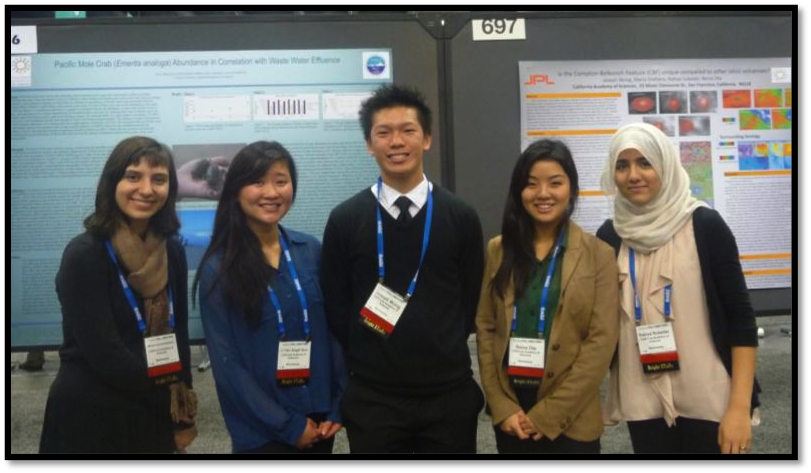Science News
Interns at the AGU
December 14, 2012

At last week’s American Geophysical Union (AGU) Meeting in San Francisco, thousands of international scientists presented their research on a variety of topics to their peers, the press, and the public.
The conference gave the same opportunity to younger scientists, through the AGU’s Bright STaRS program. “The program began in 2003 to get schools kids to the AGU meeting,” according to Pranoti Asher, manager of education for the AGU. She also reports that the number of middle and high school students attending has grown from 31 in 2003 to 128 this year.
Two teams from the Academy’s Careers in Science (CiS) intern program were among the Bright STaRS participants. The CiS program serves youth from communities traditionally underrepresented in the sciences with opportunities to immerse themselves in the natural world, develop life and job skills, receive college and career mentorship, and learn science and sustainability concepts in an authentic, paid work environment.
In a poster session that included 2,500 posters from professional and young scientists, CiS interns presented two very diverse posters—one on volcanism on the Moon and the other on sand crabs that live on Ocean Beach.
The first team worked with a scientist at NASA/JPL, using data and images gathered by the Lunar Reconnaissance Orbiter (LRO). The high schoolers decided to look at a volcanic structure on the far side of the Moon called the Compton-Belkovich Feature (CBF). Their question: How similar or different is CBF to volcanoes on the near side of the lunar surface?
The young researchers looked at albedo, elevation, radioactive thorium concentration and the surrounding geology. The youth found that Compton Belkovich is very different from other lunar volcanoes. Next, the team will attempt to identify potential sites that will yield the safest landing location and most scientific benefit.
A little closer to home, the second team looked at the influence of wastewater effluence on the population of sand crabs on San Francisco’s Ocean Beach. The Oceanside Treatment Plant lies just south of the beach and deposits copper, zinc and ammonia into the ocean.
The interns wondered what effect these chemicals have on the native Pacific mole crabs (Emerita analoga), which are a big part of the local ecosystem. Looking at previous studies on marine invertebrates, the team hypothesized that all three chemicals would negatively affect the abundance of these sand crabs.
The CiS interns have been studying the Pacific mole crabs on Ocean Beach for the past ten years. Using the data they collected between 2007 and 2010 and studying EPA data for the same four years, these young scientists found that while copper and zinc were bad for the populations, ammonia actually increased the abundance of these crustaceans.
Both teams enjoyed presenting to other researchers and their own Bright STaRS peers. Professional scientists seemed to thoroughly enjoy the presentations and gave the youth advice on where to take their research next.
And the high schoolers?
“My favorite part of AGU was presenting our research,” says senior Mollie. “Just like when teaching a lesson on the public floor of the museum, Angel and I had to gauge our visitor's level of interest, and previous scientific knowledge. By tailoring our presentations and focusing on clearly and succinctly communicating our research, I felt I became more familiar with our project and its subtleties. Additionally, visitor's suggestions and critiques of our project invigorated my interest in taking our Pacific mole crab research further in future years.”
“It was my first time at AGU and I had a wonderful time meeting scientists and presenting the research on lunar volcanoes to all,” says senior Rabiya. “It was definitely an amazing experience to be in a place where everyone is excited and curious about the same thing—the sciences!”
Image: Careers in Science Interns (from left to right) Mollie, Angel, Joseph, Reina, and Rabiya